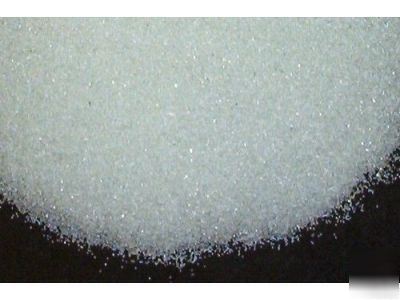WE STOCK GLASS BEAD IN THESE SIZES:
* #4 (30/40) LARGE MIN 5/32 NOZZLE
* #5 (40/50) LARGE MIN 5/32 NOZZLE
* #6 (50/70) MEDIUM MIN 1/8 NOZZLE
* #8 (70/100) MEDIUM MIN 1/8 NOZZLE
* #10 (100/170) FINE MIN 3/32 NOZZLE
* #12 (140/230) EXTRA FINE MIN 3/32 NOZZLE
GLASS BEADS ARE USED WIDELY IN MOST BLASTING CABINETS FOR PAINT, RUST AND FOREIGN MATERIAL REMOVAL FROM ALMOST ANY METAL SUBSTRATE. THEY ARE THE MOST POPULAR BLASTING MATERIAL USED IN BLAST CABINETS TODAY WITH THE POSSIBLE EXCEPTION OF SILICA SAND.
GLASS BEAD WORKS WELL FOR MOST APPLICATIONS, LEAVING A BRIGHT ATTRACTIVE FINISH WHICH IS ESPECIALLY DESIRABLE ON ALUMINUM, BRASS AND STAINLESS STEEL. FOR MOST GENERAL PURPOSE APPLICATIONS WE RECOMMEND THE #8(70/100) GLASS BEADS.
IMPORTANT NOTE: SILICA SAND SHOULD NEVER BE USED FOR SANDBLASTING AS IT WILL CAUSE SILICOSIS; A SERIOUS DISEASE OF THE LUNGS. NEVER USE SILICA IN A BLAST CABINET. THIS WILL INCREASE YOUR EXPOSURE TO FREE SILICA. FREE SILICA CANNOT BE FILTERED OUT BY USING A RESPIRATOR AND SHOULD NEVER BE USED UNLESS USING AN AIR SUPPLIED HELMUT IN AN OUTDOOR AREA WITH GOOD VENTILATION. SILICA SAND BLASTING IS KNOWN TO CAUSE SILICOSIS AND IS LISTED AS A CLASS "A" CARCINOGEN. GET EDUCATED ABOUT SILICOSIS BEFORE ENGAGING IN SANDBLASTING ACTIVITIES.
OSHA SHOULD BE CONTACTED IF YOUR EMPLOYER IS USING SILICA SAND IN A BLAST CABINET OR OTHER EQUIPMENT WITHOUT PROPER AIR QUALITY TESTING, SAFETY EQUIPMENT AND EMPLOYEE EDUCATION ABOUT SILICOSIS.
Glass beads are not recommended for blasting light gauge sheet metals because of the potential for damage. Glass bead has a very high impact or peening effect due to its rounded particle size. The entire mass of the glass sphere is concentrated on impact. Much like a ball peen hammer, this causes thousands of very tiny concave shapes to be hammered into the substrate but with no base metal removal. Larger glass bead sizes will increase the peening force applied to the substrate and will increase the potential for damaging light gauge metals.
